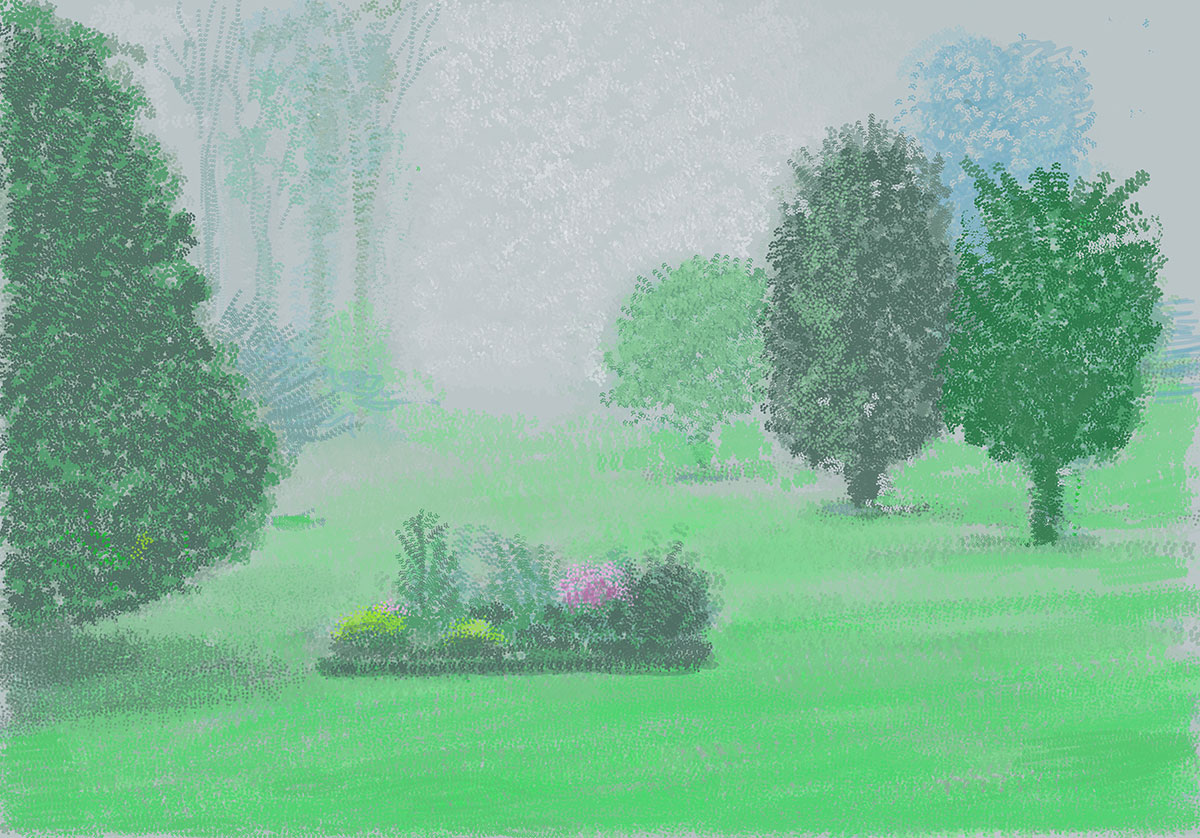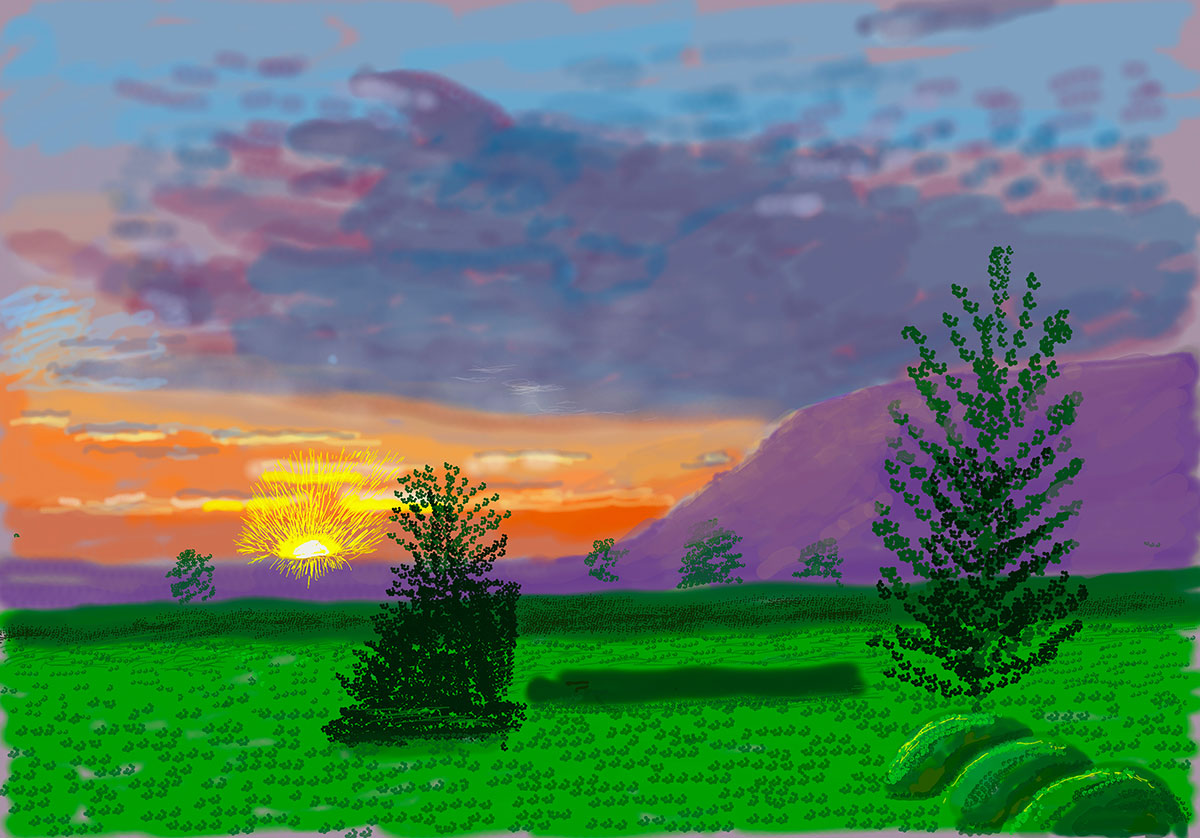PRESENTATION: David Hockney The Arrival of Spring, Normandy, 2020
David Hockney, known for bold colors and landscapes, has long been interested in the technology of art and using new media to make art. He wrote a book about evidence that the old masters used devices liked a camera lucida. He has used Polaroid film, color photocopiers and fax machines, and in 2009, began sending friends daily drawings of flower bouquets made on his iPhone.
By Efi Michalarou
Photo: The Art Institute of Chicago Archive
Two years ago, at the beginning of the COVID-19 pandemic, David Hockney traveled to France with the express intention of capturing the emergence of spring. He spend his days scrutinizing and recording the subtle, daily changes in the plants and light as spring emerged and took hold with all its drama and glory. This approach was particularly fitting for his endeavor due to Normandy’s associations with the origin of French Impressionism. . His solo exhibition “The Arrival of Spring, Normandy, 2020” marks his third series documenting the blossoming of spring, having done his first in 2011 and the second in 2013. For this latest project, he observed the richness of the season from the bucolic surroundings of rural Normandy. Working en plein air, he spent his days scrutinizing and recording the subtle, daily changes in the plants and light as spring emerged and took hold with all its drama and glory. The plein air approach was particularly fitting for his endeavor due to Normandy’s associations with the origin of French Impressionism. As Hockney noted, Monet witnessed and recorded 40 springs in nearby Giverny. The series of works was produced entirely on an iPad. The artist first explored this format in 2010 after working on an iPhone for a year prior. An app adapted to his requirements with custom brushes and shapes, “I feel like I’m painting,” Hockney remarked. His iPad works possess all the qualities of his paintings on canvas, with his gesture and hand clearly evident. This series of work coincided with the beginning of the coronavirus pandemic, when much of the world went into a state of lockdown. Hockney’s exploration offers a contrast to the isolation and loss many experienced during this same period. His paintings are a celebration of the joy of the natural world, which reminds us, as he does himself in one of his often-repeated phrases, to “love life.” The art critics have shown mixed reactions to Mr. Hockney’s use of technology like the iPad. “They can never hide their electronic origins, no matter how painterly they appear. There’s something inescapably dead and bland and gutless about them. Openness to technical innovation is one thing, art another” wrote Adrian Searle in The Guardian. But in The New York Times, Roberta Smith wrote, “This array forms an in-depth portrait of the artist as a tradition-fluent progressive working nonstop at the height of his powers, deftly juggling digital and analog modes of representation and energetically pursuing newness on several fronts”.
One of five children, David Hockney was born in 1937 in Bradford, Yorkshire. He lived there until 1953 when he began his studies at the Bradford School of Art, where he received traditional art training. After graduating in 1957, he became a conscientious objector and worked as a hospital orderly for his National Service. When his service was done, in 1959, he began his studies at the Royal College of Art, London. During that time he showed his art in the Young Contemporaries exhibition at the RBA Galleries and began to gain critical acclaim for his work, which was often lighthearted. Soon a leading Pop artist, although he himself rejected the label, he turned to more traditional representations with a focus on painting portraits. Moving to the United States in the 1960’s, he embraced his homosexuality, with his artwork exhibiting homo-erotic content. Besides portraits and homosexuality, another one of his favorite themes from his time in the United States was the swimming pool, which was more a display of his love for Los Angeles. A brilliant painter, draughtsman, printmaker, photographer, designer, and writer, Hockney is considered one of the most influential British artists of the 20th century. Currently residing in Kensington, London his artwork for the past few decades has been derived from Popular Art and culture that is coupled with his love of photography and a pre-occupation with light and economy of technique that results in a frank, honest, and humorous realism in his work. Hockney’s work has always been distinctive and versatile, whether through his realistic and serious portraits or his exotic landscapes.
Photo: David Hockney. 27th April 2020, No. 1. © David Hockney
Info: Curator: Edith Devaney, The Art Institute of Chicago, 111 S Michigan Ave, Chicago, IL, USA, Duration: 20/8/2022-9/1/2023, Days & Hours: Mon & Fri-Sun 11:00-17:00, Thu 11:00-20:00, www.artic.edu/





Right: David Hockney. 11th April 2020, No. 2. © David Hockney



